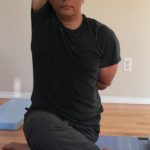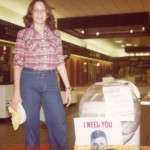I’ve been an avid AARP (American Association of Retired Persons) member for nearly ten years now. Does that make me elderly? A senior citizen? In my Northern California community, membership at our local — albeit very active — senior center can start at 50 years old. Ironically, an offer to join AARP came when I turned 48 years old. Some peers may have been horrified to get this in the mail but since I have a progressive chronic health condition, I’ve felt an inclination toward the senior set for many years.
It started with yoga – a favorite self-care practice of mine – when I realized most of my classmates were several years older than me. It was gentle yoga class and it was the right pace for me. There were poses I could do that many of my senior friends couldn’t but there were some yogis 70+ years old that were in amazing shape and had great stamina. Few of them had been practicing yoga for a while; it was part of a gradual self-care routine they adopted to not only prolong their life but enhance the quality of their life.

Since my chronic health condition has no cure or treatment, I’ve also gradually adopted self-care behaviors related to diet, movement and exercise, attitude, social support, and relaxation. None of these alone is the silver bullet but they all help me to maintain more quality in my life.
Somewhere…somehow… seniors, and those with disabling health conditions, were put in the same bucket. I’m on Medicare though I’m not yet 65 years old. As I understand, though, nearly 80% of seniors have at least one chronic health condition. It makes sense. As a nation, we’re living longer but not all of us are living well. And that’s where my radical self-care comes in. How can we keep our mental, physical, and spiritual selves healthy?
The seasonal change is happening. Do you feel a chill in the air? Are you eating or drinking something with pumpkin spices? Let’s start our self-care exploration with the cold and flu season.
Flu Season
It’s a myth that lower temperatures cause colds or the flu. Many believe it’s due to our spending more time indoors, being around more people and greater exposure to germs. All I know is, it’s hard for me not to have some respiratory reaction to an airplane flight, especially cross-country ones.
Ya’ll (I’m originally from South Florida) get the annual flu shot, right? The availability of it has increased. Workplaces offer flu shots, chain pharmacies have it at low cost. I think I’ve even heard about churches that offer it on designated days.

Doctors recommend that you get the flu, or influenza, shot by the end of October. It takes a couple of weeks to work its way into your system; that’s why I went for mine this morning because in two weeks, I’ll be on an airplane. The vaccination is self-care but there are several other behaviors you’ll need to practice to avoid the flu. Unfortunately, the shot is not 100% effective but is the first step toward fortifying yourself for the season.
My friend, Lee, a respiratory therapist has Seven Tips for Respiratory Health for you:

Get the annual flu vaccine
Colds and flus are caused by viruses. To debunk another flu shot myth, you won’t catch the flu from the vaccination. Minor side effects may include soreness, or redness and tenderness at the injection spot. I’ve experienced mild discomfort for an hour or two but nothing I couldn’t handle. And I’m a bit of a wimp.
Practice oral hygiene
I grew up with the sense that my mouth and the rest of my body were separate entities. We have separate dental and health plans. Do you ever visit a dentist in a hospital where other physicians work? But the oral cavity is not an isolated system. Studies have shown links between poor oral hygiene and the flu as well as other infections that impact the rest of your body.
People with muscular weakness, like myself, and many seniors, have difficulty brushing their teeth. The electric toothbrush, for me, is a better invention than sliced bread. There are even electric flossers.
Treat upper respiratory tract infections
Infections like sinusitis and the seasonal cold should be addressed promptly as they can lead to lower respiratory problems. Respiratory Therapist Lee recommends sinus irrigation throughout the year. There are many over-the-counter products to cleanse your sinuses or you can use a neti pot. Be proactive if you feel unusually fatigued or run a low fever.
I had a bout of sinusitis nearly ten years ago. It began as mild congestion which was easy to ignore. But then I had these fierce headaches which I was convinced were due to a brain tumor. You know how your mind can run wild. After a trip to an ER, I was relieved to get the diagnosis and receive treatment. At that point an ER doc recommended sinus irrigation to me and I’m pleased to say I’ve not had another sinusitis occurrence.
Remember to hydrate
Okay, I’m putting my radical self-care hat on now. Good hydration does not include sugary drinks like soda pop, Frappuccino’s, and juice. A little juice added to your still or sparkling water is fine. The goal is to create a good electrolyte balance to help produce normal mucus. Think of food and beverages as medicine. Are you consuming ingredients that propel good health? Don’t forget, many fruits and vegetables contain water such as cucumbers and melon.
Maximize nutrition
I’ve still got that hat on. I’m a big believer in Food = Medicine. I could go on and on about nutrition and diet…but I won’t. If you tend to eat the Standard American Diet (SAD) with lots of sugar, fat, and processed foods, try taking a break when your immune resistance may be lowered. We’ll talk more about immunity, but the immune system declines as we age and especially if we have poor nutrition. When we have respiratory stress, our system is on overload and consumes more calories to help us breathe. We can debunk another myth — feed a cold, starve a fever – and opt for eating small, more frequent meals with nutritional density.
Move and exercise safely
Try not to be a couch potato. Light exercise and movements such as stretching can go a long way even when you’re feeling a little under-the-weather. Moving your body promotes good circulation which allows the cells in your immune system to move more freely in your body and be more effective. Lee especially recommends coordinating movement with breathwork as done in practices such as yoga, tai chi, and qigong. The focused breathing increases your blood neutrophil count, improves your immune function, helps maintain our white blood cell count, and improves your gas exchange (oxygen in, carbon dioxide out).
Sleep
Sleep is the foundation of my self-care pyramid. Many of my daily activities are intentionally focused on cultivating a relaxing sleep experience for that evening. I am certainly not alone as there are numerous books, magazine articles, and classes instructing us on how to get better sleep. There is evidence-based research, as well as lots of anecdotal sharing, to suggest how our bodies respond to stimuli that either help or hinder our sleep. I’ve experimented with a lot of modalities. Personally these are four of the most important: (1) have some physical activity during the day preferably earlier in the day; (2) eat your last meal at least three hours before bedtime; (3) take a warm bath before getting into bed; and, if you’re so inclined, (4) a couple drops of a CBD or 1:1 sublingual tincture.
Not covered in Lee’s Tips are the following but I’m sure she’d agree on their importance:

Common Cold Can Become Pneumonia
While the flu shot is essential, there are other vaccinations that both people 65 years or older and those with chronic health conditions need to consider. There’s the pneumonia vaccine. Pneumonia is an infection of the lung air sacs located deep in the lungs which, according to the Centers for Disease Control and Prevention (CDC), kills 50,000 Americans each year.

Here’s what’s the most confusing – viruses, bacteria, and fungi can all cause pneumonia. In the U.S. the most common causes of viral pneumonia are influenza and respiratory syncytial virus (RSV). The most common cause of bacterial pneumonia is streptococcus pneumoniae.
There are now two recommended pneumococcal bacteria vaccines. The first one to get is PCV13 (Prevnar). A year later you should get PPSV23 (Pneumovax). They protect against different strains.
When I first learned about the importance of these vaccinations, I went to my neurologist for advice. Unfortunately, he was unclear about their names and which to get first. Thankfully, I consulted my General Practitioner physician, and she provided clarity.
I view these vaccinations as part of my self-care regimen. I was curious if others felt similarly so I conducted a brief online survey. Of course, this is not evidence-based research; it’s totally anecdotal based on my friendships with people 65 years or older (seniors) and those under 65 years old who have a chronic health condition.
I sent the survey link to 58 friends (29 in each of the groups described above). They were not aware of their “group.” Approximately 40% responded to the 2-minute survey questions with nearly equivalent group representation.
Almost all respondents get the annual flu shot. But 2/3 of the “senior” group reported getting the pneumonia vaccine while only 1/3 of the “non-senior” group did. And those that did get the vaccination generally did not know whether it was the Prevnar or Pneumovax.
Clearly more education is needed. A cold or flu could develop into pneumonia. People with weakened immune systems are more likely to have this happen. Our immune system – comprised of white blood cells, antibodies, the complement system, the lymphatic system, the spleen, the thymus, and the bone marrow – generates antibodies to combat a virus. If someone is on immunosuppressant medications, or has an immune-compromised system, a virus is more difficult to treat.
Let’s get back to the idea of being proactive, as Lee suggested. Bronchitis is an infection of the lung air passages and far more common than pneumonia yet still serious. Upper respiratory infections like colds, sinus infections, and bronchitis are often mis-treated with prescriptions for antibiotics. But these infections are typically viral and won’t respond to antibiotics. Often a chest x-ray is the only way to diagnose if the infection is upper respiratory or lower respiratory such as pneumonia.
I was an antibiotic junkie in my youth. Not willfully, of course. Every other month my pediatrician dispensed erythromycin like candy for all types of ails. And I’m sure most of it was totally unwarranted. You’ve probably read how the overuse of antibiotics has created a drug resistance. The CDC reports that two million Americans get antibiotic-resistant infections each year and 23,000 will result in death.
This fact alone justifies a greater effort toward self-care and building greater immunity. We can’t rely on antibiotics as the silver bullet or as Google defines, “a simple remedy for a difficult or intractable problem. [From the belief that werewolves could be killed with silver bullets.]”
Live Longer and Healthier
One in every 8 Americans is 65 years or older. This percentage is growing at a rapid pace as baby boomers become part of the senior set.

The United Health Foundation publishes an annual report on the health of seniors in the United States. In the most recent report the good news is that smoking rates are lower, early death rate is lower, and seniors report a higher health status than previous years. The bad news, though, is excessive drinking is 42% higher, obesity and diabetes are 36% higher, and the suicide rate for seniors has increased by 16%.
One of the reasons we are experiencing greater longevity is certainly due to advances in medical and pharmaceutical research. For example, my father was a smoker for much of his life until his mid-40s. In his 60s he experienced a heart attack and has since been taking statin drugs. He’ll turn 85 soon and I assume without the statins he might not still be with us. I know his diet has changed since my meat and potato childhood, but I suspect his genetics play a role too. I inherited my genetic disease from my mother.
The aging process does tend to impact our immune response. That’s why respiratory infections, influenza, and pneumonia are the leading causes of death in people 65 years and older. But there are self-care practices, in addition to vaccinations, that we can practice to enhance our immunity.

There’s a strong connection between nutrition and immunity for people in their senior years. Dr. Joel Fuhrman, author of the book, Super Immunity: The Essential Nutrition Guide for Boosting Your Body’s Defenses to Live Longer, Stronger, and Disease Free, believes the key is in phytochemicals found in fruits and vegetables that strengthen and support normal immune function. Animal and processed food products do not contain these immune-supporting nutrients. Generally, it’s agreed that supplements and other products touted to boost one’s immunity are not effective. Eating whole, fresh, and organic foods are the best source for phytochemicals.
The Next Step in Self-Care
In spite of what we now know about a healthy lifestyle (diet, exercise, etc.), cancer is still a force to reckon with. More than 60% of cancer patients are older adults. This percentage is expected to rise to 70% in the next two decades. Yet I bet you have many friends who have survived bouts of cancer; remember when the diagnosis was surely a death sentence?
As a final self-care practice, I’d like to suggest being more pro-active in helping the scientific research community. For the last ten years I have participated in a number of research studies for my genetic muscle disease. One longitudinal study included three paid trips to Rochester, New York where I had the focused attention of an incredible healthcare team. The other studies have been shorter, and a few were online surveys.
Participation in research and clinical trial studies not only benefit the study participant but they also help move the needle a little bit closer to finding treatments and cures. I don’t know if I’ll see a cure to my disease in my lifetime, but I do hope my participation has helped.

While I mentioned above how cancer impacts older adults, the Food and Drug Administration (FDA) has found that only 40% of patients participating in cancer clinical trials are 65 years or older. We know that our bodies, and immune systems, change as we age. These changes impact how our bodies respond to drugs and other health interventions. That’s why it’s critical to have older bodies involved in the research process.
You don’t have to have cancer, or a genetic disease like myself, to participate in clinical trials. Research studies also look for healthy controls to participate. After you get your annual flu shot and figure out if you’ve received the necessary pneumonia vaccinations, why don’t you visit the Clinical Trials government website to see if you’re eligible for any studies in your area?
May you stay healthy and discover your own self-care practices.
Thank you to CureClick for sponsoring this post. All opinions are 100% my own. CureClick is committed to supporting patients, caregivers, patient advocates and life science companies through education about health, science and clinical trials.





